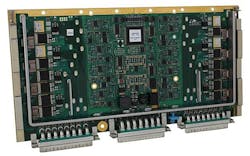Army to receive solid-state power controller boards from DDC in $1.9 million contract award
Officials of the Defense Logistics Agency (DLA) in Warren, Mich., on Friday announced their intention to award a contract to DDC worth an estimated $1.9 million for 187 power-controller circuit card assemblies for the Bradley turret system.
DLA-Warren officials are awarding the contract to DDC sole-source because the company is the only responsible source for the power-controller board. DLA-Warren is awarding the contract on behalf of the Army TACOM Life Cycle Management Command (LCMC) in Warren, Mich. Officials quote the per-board cost of the DDC devices at $5,192.15.
The DDC-designed card is a 28-volt 14-channel solid-state power controller based on DDC's latest generation of multi-channel solid-state power controller boards and can distribute and control power to as many as 14 independence subsystems.
The DDC power controllers feature automated power control to simplify crew operation; automated load shedding; diagnostic and prognostic data; automated and preventive maintenance; improved mission safety and longevity; power quality profiling and analysis; increased system up-time and reliability; reduced power dissipation; and reduced electro-magnetic interference.
(story continues below)
DDC engineers developed and tested the board at the company's own expensive, and its design data is considered proprietary to DDC, Army officials say.
Opening the procurement to competition from other potential sources would take longer than two years, Army officials estimate, and would impose delays unacceptable to TACOM and would have significant detrimental impact on TACOM's ability to support the soldier in the field, Army officials say.
Related: Data Device Corp. to provide Navy with PC/104 1553 and 429 cards in $4.4 million contract
DDC designed the power-controller cards for military land vehicles; commercial trucks; industrial controls; military and commercial ships; weapon systems; unmanned ground vehicles (UGVs); and unmanned aerial vehicles (UAVs).
The Bradley Fighting Vehicle, manufactured by BAE Systems Land and Armaments in Santa Clara, Calif., is designed to transport infantry or scouts with armor protection while providing covering fire to suppress enemy troops and armored vehicles.
There are several Bradley variants, including the M2 Bradley infantry fighting vehicle and the M3 Bradley cavalry fighting vehicle. The M2 holds a crew of three: a commander, a gunner and a driver, as well as six fully equipped soldiers. The M3 mainly conducts scout missions and carries two scouts in addition to the regular crew of three, with space for additional TOW missiles.
Related: Databus bridge from DDC translates avionics networking among 1553, ARINC 429, and Ethernet
The Bradley's primary armament is a 25-millimeter cannon that fires as many as 200 rounds per minute and is accurate to 1.5 miles. The combat vehicle also has two missile launchers for TOW antitank missiles able to destroy enemy main battle tanks as far away as 2.3 miles.
For more information contact DDC online at www.ddc-web.com, or the DLA-Warren at www.landandmaritime.dla.mil.
